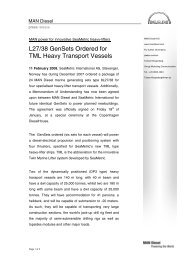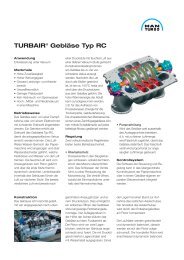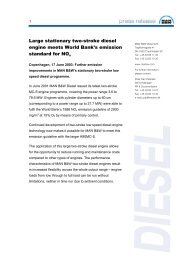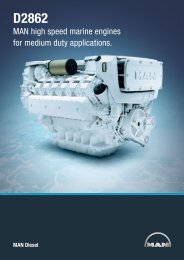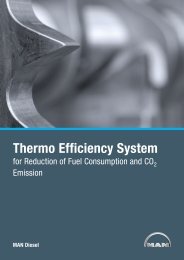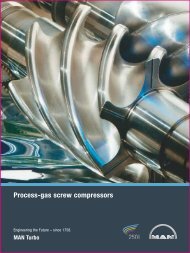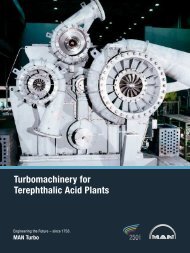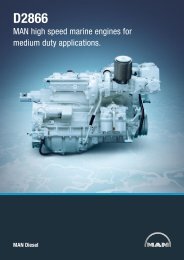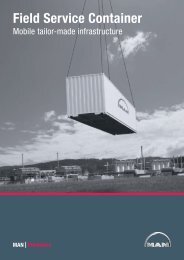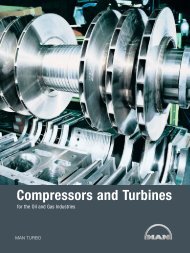Download file - MAN Diesel & Turbo SE
Download file - MAN Diesel & Turbo SE
Download file - MAN Diesel & Turbo SE
You also want an ePaper? Increase the reach of your titles
YUMPU automatically turns print PDFs into web optimized ePapers that Google loves.
Ambient Temperature Operation and Matching<br />
<strong>MAN</strong> B&W Two-stroke Engines<br />
Introduction<br />
All diesel engines that are used as<br />
prime movers on ships are exposed<br />
to the varying local climatic conditions<br />
that prevail throughout the world.<br />
In some areas, the ambient sea and<br />
air temperatures can, occasionally,<br />
be extremely high. Likewise in arctic<br />
areas, the temperatures can be<br />
very low. Under both extreme temperature<br />
conditions some engine design<br />
precautions might be necessary<br />
to enable the engine to operate in unrestricted<br />
service.<br />
This paper will outline operation possibilities<br />
with a standard matched engine<br />
in any extreme temperature environment<br />
and describe the possibilities for<br />
special matching of engines for more<br />
permanent operation under such conditions.<br />
Standard ambient temperature<br />
matched engine<br />
Standard unrestricted service<br />
demands<br />
For a standard main engine, the engine<br />
layout is based on the ambient<br />
reference conditions of the International<br />
Standard Organization (ISO):<br />
ISO 3046-1:2002(E) and<br />
ISO 15550:2002(E):<br />
ISO ambient reference conditions<br />
Barometric pressure:<br />
1,000 mbar<br />
<strong>Turbo</strong>charger air intake<br />
temperature: 25ºC<br />
Charge air coolant temperature:<br />
25ºC<br />
Relative air humidity: 30%<br />
With this layout basis, the engine must<br />
be able to operate in unrestricted service,<br />
i.e. up to 100% Specified Maximum<br />
Continuous Rating (SMCR), within the<br />
typical ambient temperature range that<br />
the ship is exposed to, operating from<br />
tropical to low winter ambient conditions.<br />
According to the International Association<br />
of Classification Societies (IACS)<br />
rule M28, the upper requirement, normally<br />
referred to as tropical ambient reference<br />
conditions, is as follows:<br />
IACS M28 (1978):<br />
Tropical ambient reference conditions<br />
Barometric pressure:<br />
1,000 mbar<br />
Air temperature: 45ºC<br />
Seawater temperature: 32ºC<br />
Relative air humidity: 60%<br />
The above tropical ambient relative humidity<br />
of 60% at 45ºC is theoretically<br />
the absolute limit at which it is possible<br />
for humans to survive. The corresponding<br />
wet bulb temperature is 36.8ºC.<br />
<strong>MAN</strong> <strong>Diesel</strong> has never measured levels<br />
above 50% at 45ºC, and humidity levels<br />
above standard tropical ambient<br />
conditions will never occur.<br />
When applying the central cooling water<br />
system which, today, is more commonly<br />
used than the seawater system,<br />
the corresponding central cooling water/scavenge<br />
air coolant temperature is<br />
4ºC higher than the seawater temperature,<br />
i.e. equal to 36ºC.<br />
The winter ambient reference conditions<br />
used as standard for <strong>MAN</strong> B&W<br />
two-stroke engines are as follows:<br />
Winter ambient reference conditions<br />
Barometric pressure:<br />
1,000 mbar<br />
<strong>Turbo</strong>charger air intake<br />
temperature: 10ºC<br />
Cooling water temperature:<br />
(minimum for lub. oil cooler)<br />
10ºC<br />
Relative air humidity: 60%<br />
Shipyards often specify a constant<br />
(maximum) central cooling water temperature<br />
of 36°C, not only for tropical<br />
ambient conditions, but also for winter<br />
ambient conditions. The purpose is to<br />
reduce the seawater pump flow rate<br />
when possible, and thereby to reduce<br />
the electric power consumption, and/or<br />
to reduce the water condensation in the<br />
air coolers.<br />
However, when operating with 36°C<br />
cooling water instead of for example<br />
10°C (to the scavenge air cooler), the<br />
Ambient Temperature Operation and Matching - <strong>MAN</strong> B&W Two-stroke Engines<br />
5



